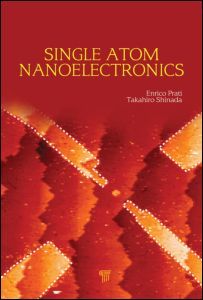Single-Atom Nanoelectronics
Coordonnateurs : Prati Enrico, Shinada Takahiro

Single-Atom Nanoelectronics covers the fabrication of single-atom devices and related technology, as well as the relevant electronic equipment and the intriguing new phenomena related to single-atom and single-electron effects in quantum devices. It also covers the alternative approaches related to both silicon- and carbon-based technologies, also from the point of view of large-scale industrial production. The publication provides a comprehensive picture of the state of the art at the cutting edge and constitutes a milestone in the emerging field of beyond-CMOS technology.
Although there are numerous publications on nanoelectronics, no book highlights the effect of a single atom on device performance, which can be beneficial for making extensive use of CMOS technologies. This book is the first to deal with topics related to single-atom control, which is the final frontier for nanoelectronics.
Enrico Prati received a bachelor’s in theoretical physics in 1998 from the University of Pisa and a PhD in physics in 2002. From 2003 to 2008, he worked at Istituto Nazionale di Fisica della Materia (INFM) and from 2009 he is permanent researcher of Istituto per la Microelettronica e Microsistemi (IMM) of Consiglio Nazionale delle Ricerche (CNR) in Agrate Brianza. In February 2004 he received the Young Scientist Award from the URSI for his work on negative refractive index propagation and metamaterials. From 2011, he has contributed to the International Technology Roadmap for Semiconductors (ITRS) Emerging Research Materials (ERM) Committee on deterministic doping. His present research fields are both theoretical and experimental aspects of low-dimensional electron systems, quantum transport, deterministic doping for More than Moore applications, and quantum information in solid state. At present Dr. Prati is secretary of the Associazione Italiana per la Ricerca (www.associazionericerca.it) .
Takahiro Shinada received a PhD in engineering in 2000 and an MBA in technology management in 2007 from Waseda University. From 2000 to 2012 he worked at Waseda University, where he was promoted to associate professor in 2006. Since 2012 he has been with the National Institute of Advanced Industrial Science and Technology (AIST), serving as the senior officer for advanced nanodevice research. He is a member of the International Technology Roadmap for Semiconductors (ITRS) Emerging Research Devices (ERD) and Emerging Research Materials (ERM) Chapters. His research concerns are deterministic doping in nanoelectronics for extended CMOS applications and its application in biological systems for environment, safety, and health (ESH) issues.
Date de parution : 04-2013
15.2x22.9 cm
Thèmes de Single-Atom Nanoelectronics :
Mots-clés :
Single Ion Implantation; Gate Voltage; Circuits with Single-Atom Devices; Quantum Dots; Using Scanning Tunneling Microscopy to Realize Atomic-Scale Silicon Devices; Dopant Atom; Single-Ion Implantation for Quantum Computing; Nuclear Spin; Orbital Structure and Transport Characteristics of Single Donors; Individual Dopants; Silicon-Based Single-Dopant Devices and Integration with Photons; Single Atom Nanoelectronics; Electron Spin; Dopant Distribution; Atom Probe Tomography; Single Electron Tunneling; STM Image; Nano CMOS Era; Nv Center; Single Atom Transistors; SOI; CB; Channel Region; Coherence Time; Ion Implantation; Sim; Single Atom Devices; poly-Si Gate; Drain Current; Secondary Electron Detection



